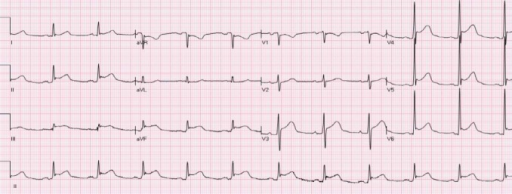Playlist
Show Playlist
Hide Playlist
Classification of Acute Pericarditis
-
Slides Myocarditis Pericarditis.pdf
-
Reference List Pathology.pdf
-
Download Lecture Overview
00:00 There are six basic flavors of pericarditis, but they overlap quite a bit. So, there’s serous pericarditis which is just going to be an effusion or a transudate of basically water and a little bit of electrolyte. There’s hemorrhagic pericarditis which is clearly bloody and this is due to vessel actual hemorrhage as opposed to vessel leakiness in a serous pericarditis. There is serofibrinous pericarditis, somewhere between serous and hemorrhagic where we are getting enough leakage of large proteins, say in the coagulation pathway, that we get fibrin evolution and cross linking. There is caseous pericarditis that looks like cheese grossly, typically associated with tuberculosis. 00:44 We have suppurative pericarditis which just means we have a very prominent neutrophilic infiltrate and we have chronic or healed pericarditis. Six flavors, actually there’s a lot of overlap. So, don’t get too bogged down and say, “Oh, this is going to be a serous.” We’ll talk about kind of big bins to think about it. So, non-inflammatory transudates will give rise primarily to a serous pericarditis, so non-inflammatory, non-malignant transudates, just you know, fluid, water and electrolytes typically associated with uremia. Okay. Also with heart failure or with hypoalbuminemia so that we do not have the normal oncotic pressure to keep fluid, electrolytes, water within the vasculature and it transudates into the pericardial sac. So, non-inflammatory transudates. Exudative pericarditis is associated with acute MIs. Dressler’s syndrome or a post-surgical postpericardiotomy syndrome and is perhaps the most frequent type of pericarditis that we’ll see overall although normally it doesn’t come to attention, say at autopsy. So, it happens with an acute MI, post-infarction, post-surgery, or as part of the Dressler’s syndrome. Hemorrhagic pericarditis means that we’ve actually formally broken blood vessels. We have now substantial hemorrhage into the pericardial sac. This can occur with malignant neoplasms which are a common cause. It can happen with bacterial infections causing substantial vascular destruction. It can happen if the patient just happens to have an underlying bleeding diastases. They are more prone to bleeding wherever they get vascular injury. Tuberculosis can do this by causing substantial damage and, importantly, for all pericarditis whether it’s hemorrhagic or other forms of pericarditis, anything more than an acute accumulation of about 200 cc is enough to kill you with pericardial tamponade. However, if you have a slow motion accumulation, say with malignancy or with a certain infection or other causes, you can accumulate an excess of a liter of fluid and the pericardium will stretch and stretch and stretch so that you don’t have acute tamponade. You may, eventually, at 1000 cc develop tamponade physiology. But 200 cc all at once, say with an aortic dissection is enough to kill you. Exudative pericarditis that’s the suppurative pericarditis just means there are a lot of inflammatory cells there. They typically mean it’s going to be an active infection and microbial invasion. And tuberculosis is going to be key amongst those. Those will also tend to have caseation. They will have central zones where very prominent necrosis occurs that looks grossly like cottage cheese or curds, and hence, the name caseous pericarditis. The most common cause of caseation is tuberculosis but fungus can do this as well. And caseous pericarditis is a common antecedent of disabling fibrocalcific chronic constrictive pericarditis, something that will eventually scar and restrict normal cardiac excursion and dilation. Other causes of pericarditis can do this as well, but if we’re looking at the most common cause of fibrocalcific chronic constrictive pericarditis worldwide, it’s tuberculosis. So, chronic pericarditis, we mention that, what is that? It’s a consequence of the healing of any form of pericarditis, malignant, serous, hemorrhagic, fibrinopurulent, whatever, take your favorite flavor. 04:36 As that heals, as that fluid in that space organizes, it will fibrose and it can be a cause of a constrictive cardiomyopathy, meaning that the heart cannot dilate during diastole, it cannot fill. It will contract just fine but it will have constrictive cardiomyopathy physiology. So, this is just as an example of this chronic pericarditis of whatever cause that has led to a very thickened, fibrous, and focally calcified pericardium that's being lifted away by the forceps from the underlying heart. There's not much fluid in that space anymore but it’s a very dense fibrous scar that will limit excursion, diastolic relaxation of the heart and can, as I say, be a cause of constrictive pericarditis and will cause diastolic dysfunction.
About the Lecture
The lecture Classification of Acute Pericarditis by Richard Mitchell, MD, PhD is from the course Myocarditis and Pericarditis.
Included Quiz Questions
What is a cause of noninflammatory transudative pericarditis?
- Uremia
- Acute myocardial infarction
- Dressler syndrome
- Bacterial infection
- Malignancy
What cause of pericarditis is associated with a hemorrhagic exudate?
- Malignant neoplasm
- Uremia
- Acute myocardial infarction
- Tuberculosis
- Fungal infection
What is an expected finding in a patient with chronic pericarditis?
- Thickened pericardium
- Dilated cardiomyopathy
- Fatal tamponade
- Caseous pericarditis
- Hypertrophic myocardium
Customer reviews
5,0 of 5 stars
| 5 Stars |
|
5 |
| 4 Stars |
|
0 |
| 3 Stars |
|
0 |
| 2 Stars |
|
0 |
| 1 Star |
|
0 |




